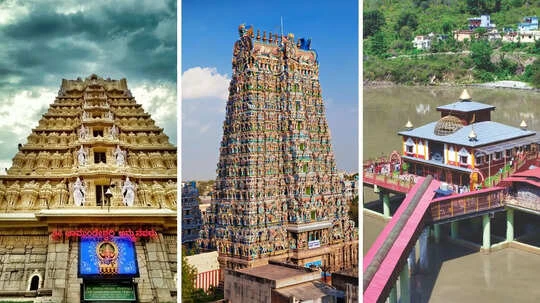Every element on this earth is a creation of Shakti. In Sanatan Dharma, the worship of Shakti is Goddess Shakti is integral and she is associated with both the creation and destruction of the universe.
She is worshipped as the Mother Goddess, or Devi. She is the force that nurtures life through her divinity, and her worship is integral to Hindu spiritual practices. It is believed that visiting a Devi temple has a profound effect on the mind and emotions.
In Shakta traditions, certain temples are also recognised as Shakti Peethas and are believed to be locations that hold powerful divine energy. Visiting a revered Devi temple can bring noticeable changes in one’s life. It is said that simply going there, praying, and spending time in the energy of these temples-which are centres of cosmic power-can be transformative. Before this year ends, you should visit these three Devi temples to enter the new year with her blessings.
Chamundeshwari Temple, Karnataka
The Chamundeshwari Temple, more than 1,000 years old, is located 13 km from Mysuru, Karnataka. The temple is dedicated to Goddess Chamundi, an avatar of Goddess Durga, who represents the fierce form of Shakti. She is celebrated as the slayer of demons Chanda and Munda, and also Mahishasura, the buffalo-headed monster. The Goddess is believed to be an incarnation of Parvati, consort of Lord Shiva.
The temple is counted among the 18 Maha Shakti Peethas, where it is believed that the hair of Sati fell. Locals believe that climbing the temple steps can help absolve past sins. Worshipping her offers protection from evil and negative forces, removes obstacles, and blesses devotees with abundance. The temple is considered a place where one can cleanse past karmic burdens.
Sri Meenakshi Amman Temple, Tamil Nadu
Located in Madurai, the Sri Meenakshi Amman Temple is one of the most famous pilgrimage sites in Tamil Nadu. It is dedicated to Goddess Meenakshi, a form of Parvati, her consort Sundareśvarar (a form of Shiva), and her brother Aḻagar (a form of Vishnu). The temple is steeped in legends and myths. According to Tamil Nadu Tourism, “It is believed that Indra discovered the presence of a Swayambhu lingam during his trip through Madurai and enshrined it. The temple finds mention in ancient texts and was completely devastated in 1310. It was restored to its original glory in the 14th century.”
The significance of the temple lies in the fact that it brings together influences of of Shaivism, Shaktism, and Vaishnavism. It is also the place where Lord Shiva married Parvati (Meenakshi), and a daily ritual reenacts their divine union, which is central to the temple’s worship. Devotees believe that visiting the temple can bring prosperity, courage, and spiritual energy for the year ahead.
Dhari Devi Temple, Uttarakhand
The Dhari Devi Temple is located between Srinagar and Rudraprayag on Badrinath Road and is dedicated to Maa Dhari Devi. She is the guardian deity of the Char Dham pilgrimage sites in Uttarakhand and is considered an avatar of Goddess Kali. The idol of Dhari Devi has two parts: the upper half represents the local deity Dhari, while the lower half, worshipped as Goddess Kali, is in Kalimath village.
According to belief, the goddess’s appearance changes throughout the day. In the morning, she appears as a girl; in the afternoon, as a young woman; and in the evening, as an old lady. Devotees hold such reverence for the Goddess that when the devastating 2013 Uttarakhand floods occurred, many attributed it to her displeasure, as her idol had been moved for a hydroelectric dam project.
